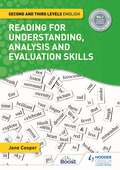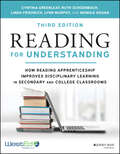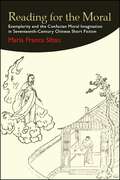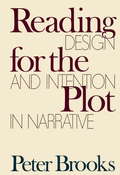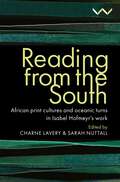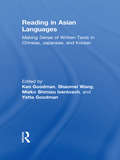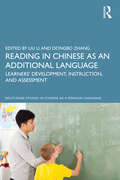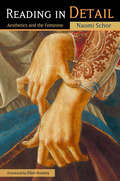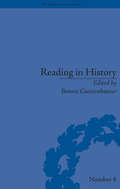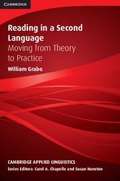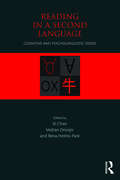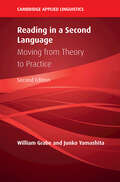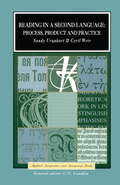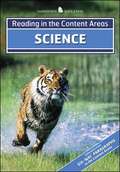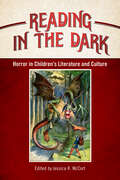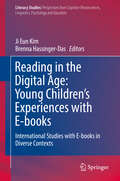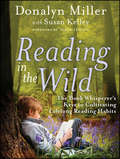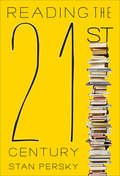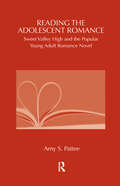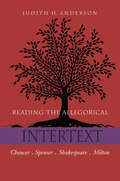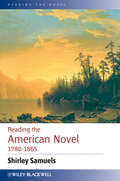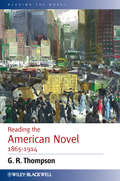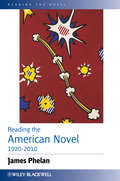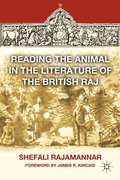- Table View
- List View
Reading for Understanding, Analysis and Evaluation Skills: Second And Third Levels English
by Jane CooperSyllabus: CfE (Curriculum for Excellence, from Education Scotland) and SQALevel: BGE S1-3: Third & Fourth LevelsSubject: EnglishCapture pupils' imagination and attention with a rich collection of quality texts, handpicked by Jane Cooper to ensure that pupils want to start reading - and keep reading.Tailored to the interests, motivations and abilities of pupils working towards Second and Third Levels in S1 to S3, this book will help you to close the attainment gap.> Unlock a world of meaning, connection and questioning. Part One teaches the close reading skills that pupils need throughout their lives, with simple explanations, lots of examples and tasks set at three levels - 'Building', 'Strengthening' and 'Extending'.> Apply and develop RUAE skills and monitor progress. Part Two contains ten practice assessments that gradually increase in difficulty, with longer passages, more complex language and more challenging questions.> Save time sourcing non-fiction text extracts. Drawing on her long career as an English teacher and author, Jane Cooper has a talent for knowing which topics pupils will find curious or fun - from the world's cheesiest pizza to a mysterious metal column that appeared in a desert.> Build the foundations for success in National qualifications. With Course Reports showing that N5 and Higher students most commonly lose marks in the RUAE papers, this book offers a proactive solution to building confidence and skills during BGE.> Support the individual needs of every pupil. Providing differentiated, age-appropriate content and tasks, this is the perfect resource for mixed-ability classrooms - especially when used alongside its companion volume, Levels 3-4 English: Reading for Understanding, Analysis and Evaluation Skills.
Reading for Understanding: How Reading Apprenticeship Improves Disciplinary Learning in Secondary and College Classrooms
by Ruth Schoenbach Cynthia Greenleaf Lynn Murphy Linda Friedrich Nika HoganImprove student outcomes in reading and literacy with the latest edition of this bestselling text The newly revised Third Edition of Reading for Understanding: How Reading Apprenticeship Improves Disciplinary Learning in Secondary and College Classrooms is the latest iteration of the best-selling, landmark book in the field of adolescent literacy. The book contains strategies for boosting the reading independence of middle, secondary, and college students. Research conducted by NSF, IES, and OIIhas validated the model taught in Reading for Understanding, demonstrating its effectiveness in raising students’ reading achievement levels. The authors teach a clear and concise instructional framework for students at all learning levels, from those with special learning needs to those taking honors and Advanced Placement courses. The book also includes: A direct correlation to disciplinary literacy, making the book an even more valuable resource in a wide range of classrooms Explanation of the social and personal dimensions for building a foundation for engaged learning Discussions of the value of setting aside dedicated class time for independent, silent readingWith collaboration tips that go beyond the classroom and advice on building a cognitive “reading toolbox,” Reading for Understanding is an indispensable resource for teachers at the Grade 6 and up, literacy coaches, reading teachers, community college instructors, and other school leaders.
Reading for the Moral: Exemplarity and the Confucian Moral Imagination in Seventeenth-Century Chinese Short Fiction (SUNY series in Chinese Philosophy and Culture)
by Maria Franca SibauReading for the Moral offers an innovative reassessment of the nature of moral representation and exemplarity in Chinese vernacular fiction. Maria Franca Sibau focuses on two little-studied story collections published at the end of the Ming dynasty, Exemplary Words for the World (Xingshi yan, 1632) and Bell in the Still Night (Qingye zhong, c. 1645). Far from being tediously moralistic tales, these stories of loyal ministers, filial children, chaste widows, and selfless friends provide a deeper understanding of the five cardinal relationships central to Confucian ethics. They explore the inherent tension between what we might call textbook morality, on the one hand, and untidy everyday life, on the other. The stories often take a critical view of mechanical notions of retribution, countering it with the logic of virtue as its own reward. Conflict between passion and duty is typically resolved in favor of duty, a duty redefined with a palpable sense of urgency. In constructing vernacular representations of moral exemplars from the recent historical past rather than from remote or fictitious antiquity, the story compilers show how these virtues are not abstract or monolithic norms, but play out within the contingencies of time and space.
Reading for the Plot
by Peter BrooksA book which should appeal to both literary theorists and to readers of the novel, this study invites the reader to consider how the plot reflects the patterns of human destiny and seeks to impose a new meaning on life.
Reading from the South: African print cultures and oceanic turns in Isabel Hofmeyr’s work
by Sunil Amrith Sarah Nuttall Gabeba Baderoon Pumla Dineo Gqola Khwezi Mkhize James Ogude Christopher EW Ouma Carolyn Hamilton Charne Lavery Karin Barber Rimli Bhattacharya Antoinette Burton Danai S Mupotsa Ranka Primorac Madhumita Lahiri Meg Samuelson Lakshmi SubramanianThis set of essays analyses the work of Isabel Hofmeyr, globally recognised as one of South Africa’s foremost literary and Indian Ocean scholars. The essays elucidate Hofmeyr’s path-breaking studies of transnational histories of the book, African print cultures, and cultural circulations in the Indian Ocean world.This book draws together reflective and analytical essays by renowned intellectuals from around the world who critically engage with the work of one of the global South’s leading scholars of African print cultures and the oceanic humanities. Isabel Hofmeyr’s scholarship spans more than four decades, and its sustained and long-term influence on her discipline and beyond is formidable.While much of the history of print cultures has been written primarily from the North, Isabel Hofmeyr is one of the leading thinkers producing new knowledge in this area from Africa, the Indian Ocean world and the global South. Her major contribution encompasses the history of the book as well as shorter textual forms and abridged iterations of canonical works such as John Bunyan’s The Pilgrim’s Progress. She has done pioneering research on the ways in which such printed matter moves across the globe, focusing on intra-African trajectories and circulations as well as movements across land and sea, port and shore. The essays gathered here are written in a blend of intellectual and personal modes, and mostly by scholars of Indian and African descent. Via their engagement with Hofmeyr’s path-breaking work, the essays in turn elaborate and contribute to studies of print culture as well as critical oceanic studies, consolidating their findings from the point of view of global South historical contexts and textual practices.
Reading in Asian Languages: Making Sense of Written Texts in Chinese, Japanese, and Korean
by Yetta Goodman Ken Goodman Shaomei Wang Mieko Shimizu IventoschReading in Asian Languages is rich with information about how literacy works in the non-alphabetic writing systems (Chinese, Japanese, Korean) used by hundreds of millions of people and refutes the common Western belief that such systems are hard to learn or to use. The contributors share a comprehensive view of reading as construction of meaning which they show is fully applicable to character-based reading. The book explains how and why non-alphabetic writing works well for its users; provides explanations for why it is no more difficult for children to learn than are alphabetic writing systems where they are used; and demonstrates in a number of ways that there is a single process of making sense of written language regardless of the orthography. Unique in its perspective and offering practical theory-based methodology for the teaching of literacy in Chinese, Japanese, and Korean to first and second language learners, it is a useful resource for teachers of increasingly popular courses in these languages in North America as well as for teachers and researchers in Asia. It will stimulate innovation in both research and instruction.
Reading in Chinese as an Additional Language: Learners’ Development, Instruction, and Assessment (Routledge Studies in Chinese as a Foreign Language)
by Dongbo Zhang Liu LiReading in Chinese as an Additional Language focuses on Chinese literacy acquisition, which has been considered most difficult by both learners and teachers of Chinese as an additional language (CAL). Three major areas are covered: (1) acquisition of Chinese characters; (2) reading comprehension subskills and reader’s identity; (3) reading instruction and assessment. The first part delves into the foundation of Chinese literacy development—how to learn and teach Chinese characters. The second part examines various learners’ reading comprehension subskills, as well as the evolution of learners’ literacy identity. The third part explores effective instructional methods and assessment practices for CAL reading development. Theoretically, this book provides frameworks and evidence from both cognitive and sociocultural perspectives on the nature of CAL reading development. Pedagogically, the book showcases how to teach and assess CAL reading skills. Methodologically, this book includes empirical studies using both qualitative and quantitative methods. In terms of scope, the book covers a much broader spectrum of issues about CAL reading research and classroom teaching than has previously been available. Writing is also discussed in several chapters. In terms of technology, the book includes discussion on how the use of computers, the Internet, and social media impacts students’ Chinese literacy acquisition. This book will help CAL researchers and educators better understand the nature of CAL reading development and become well informed about CAL classroom teaching and assessment, including the application of interactive approaches to teaching and assessing diverse reading skills.
Reading in Detail: Aesthetics and the Feminine
by Naomi SchorWho cares about details? As Naomi Schor explains in her highly influential book, we do-but it has not always been so. The interest in detail--in art, in literature, and as an aesthetic category--is the product of the decline of classicism and the rise of realism.But the story of the detail is as political as it is aesthetic. Secularization, the disciplining of society, the rise of consumerism, the invention of the quotidian, have all brought detail to the fore. In this classic work of aesthetic and feminist theory, now available in a new paperback edition, Schor provides ways of thinking about details and ornament in literature, art, and architecture, and uncovering the unspoken but powerful ideologies that attached gender to details. Wide-ranging and richly argued, Reading in Detail presents ideas about reading (and viewing) that will enhance the study of literature and the arts.
Reading in History: New Methodologies from the Anglo-American Tradition (The History of the Book #6)
by Bonnie GunzenhauserA collection of essays that offer a methodological framework for the history of reading. Focusing on a specific historical moment, it gathers statistics about such issues as literacy rates, library subscriptions, publication and sales figures, and print runs to answer questions about what was being read and by whom in a particular place and time.
Reading in a Second Language
by William GrabeThis volume, through a detailed treatment of the cognitive processes that support reading, explains how reading really works. It offers a thorough overview of important and current research, including first language research, which is not often found in second language acquisition (SLA) publications. This book is a true example of applied linguistics; it makes well-defined linkages between theory and practice, discussing the implications and applications of second language reading theories on instructional practices. It is a valuable resource and reference for action researchers, curriculum designers, teachers, administrators, and those interested in exploring theoretical issues grounded in instructional contexts.
Reading in a Second Language: Cognitive and Psycholinguistic Issues
by Xi Chen Rena Helms-Park Vedran DronjicReading in a Second Language offers a comprehensive survey of the phenomenon and process of reading in a second language, with graduate and upper-level undergraduate students in second language acquisition, psycholinguistics, and applied psychology as its primary audience. The book explores reading processes from a number of complementary standpoints, integrating perspectives from fields such as first and second language reading, second language acquisition, linguistics, psycholinguistics, and cognitive neuroscience. The first half examines major factors in second language reading: types of scripts, the cognitive and neural substrates of reading; metalinguistic awareness, word recognition, language transfer, and lexical knowledge. The second part of the book discusses the social and educational contexts in which reading development occurs, including issues related to pedagogy, the use of technology in the classroom, reading disorders, and policy making. Reading in a Second Language provides students with a full, logically organized overview of the primary factors that shape reading development and processes in a second language.
Reading in a Second Language: Moving from Theory to Practice (Cambridge Applied Linguistics)
by William Grabe Junko YamashitaUnderstanding reading abilities and their development is fundamental for language comprehension and human cognition. Now in its second edition, this book draws on research from multiple disciplines to explain reading abilities in both L1 and L2, and shows how this research can be applied in practice in order to support reading development. Research into reading has progressed a great deal since the first edition was published, so this edition has been completely updated and revised, in order to reflect these advances. All chapters present updated research studies, and completely new chapters are included on the neurocognition of reading, reading-writing relationships, and digital reading. If you want to know how reading works, no matter the language(s) involved, as well as how it can be taught effectively, this book provides a persuasive research foundation and many practical insights. It is essential reading for academic researchers and students in Applied Linguistics and TESOL.
Reading in a Second Language: Process, Product and Practice (Applied Linguistics and Language Study)
by Cyril J. Weir A.H. UrquhartReading in a Second Language sets the testing and teaching of reading against a theoretical background, discussing research from both applied linguistics and cognitive psychology. Where possible, it focuses on research into second language readers and distinguishes different kinds of reading, particularly expeditious as opposed to careful reading, and emphasizes the validity of each.Sandy Urquhart and Cyril Weir relate testing and teaching, discussing similarities and differences, providing a comprehensive survey of both methods with the emphasis on those which have been substantiated or supported by research evidence. Finally, the book proposes specific research topics, and detailed advice on how to construct tests of language for academic purposes and suggestions for further research.
Reading in the Content Areas: Science
by McGraw-Hill Jamestown Education StaffBased on the best-selling Six-Way Paragraphs books, these individual titles help students master the essential skills needed to organize, understand, and apply information in math, science, and social studies. Here are the books that will open doors for you into your content area classrooms.
Reading in the Dark: Horror in Children's Literature and Culture (Children's Literature Association Series)
by Jessica R. McCortContributions by Rebecca A. Brown, Justine Gieni, Holly Harper, Emily L. Hiltz, A. Robin Hoffman, Kirsten Kowalewski, Peter C. Kunze, Jorie Lagerwey, Nick Levey, Jessica R. McCort, and Janani SubramanianDark novels, shows, and films targeted toward children and young adults are proliferating wildly. It is even more crucial now to understand the methods by which such texts have traditionally operated and how those methods have been challenged, abandoned, and appropriated. Reading in the Dark fills a gap in criticism devoted to children's popular culture by concentrating on horror, an often-neglected genre. These scholars explore the intersection between horror, popular culture, and children's cultural productions, including picture books, fairy tales, young adult literature, television, and monster movies.Reading in the Dark looks at horror texts for children with deserved respect, weighing the multitude of benefits they can provide for young readers and viewers. Refusing to write off the horror genre as campy, trite, or deforming, these essays instead recognize many of the texts and films categorized as "scary" as among those most widely consumed by children and young adults. In addition, scholars consider how adult horror has been domesticated by children's literature and culture, with authors and screenwriters turning that which was once horrifying into safe, funny, and delightful books and films. Scholars likewise examine the impetus behind such re-envisioning of the adult horror novel or film as something appropriate for the young. The collection investigates both the constructive and the troublesome aspects of scary books, movies, and television shows targeted toward children and young adults. It considers the complex mechanisms by which these texts communicate overt messages and hidden agendas, and it treats as well the readers' experiences of such mechanisms.
Reading in the Digital Age: International Studies with E-books in Diverse Contexts (Literacy Studies #18)
by Ji Eun Kim Brenna Hassinger-DasThis edited book focuses on affordances and limitations of e-books for early language and literacy, features and design of e-books for early language and literacy, print versus e-books in early language and literacy development, and uses of and guidelines for how to use e-books in school and home literacy practices. Uniquely, this book includes critical reviews of diverse aspects of e-books (e.g., features) and e-book uses (e.g., independent reading) for early literacy as well as multiple examinations of e-books in home and school contexts using a variety of research methods and/or theoretical frames. The studies of children’s engagement with diverse types of e-books in different social contexts provide readers with a contemporary and comprehensive understanding of this topic. Research has demonstrated that ever-increasing numbers of children use digital devices as part of their daily routine. Yet, despite children’s frequent use of e-books from an early age, there is a limited understanding regarding how those e-books are actually being used at home and school. As more e-books become available, it is important to examine the educational benefits and limitations of different types of e-books for children. So far, studies on the topic have presented inconsistent findings regarding potential benefits and limitations of e-books for early literacy activities (e.g., independent reading, shared reading). The studies in this book aim to fill such gaps in the literature.
Reading in the Wild
by Donalyn Miller Susan KelleyIn Reading in the Wild, reading expert Donalyn Miller continues the conversation that began in her bestselling book, The Book Whisperer. While The Book Whisperer revealed the secrets of getting students to love reading, Reading in the Wild, written with reading teacher Susan Kelley, describes how to truly instill lifelong "wild" reading habits in our students.Based, in part, on survey responses from adult readers as well as students, Reading in the Wild offers solid advice and strategies on how to develop, encourage, and assess five key reading habits that cultivate a lifelong love of reading. Also included are strategies, lesson plans, management tools, and comprehensive lists of recommended books. Copublished with Editorial Projects in Education, publisher of Education Week and Teacher magazine, Reading in the Wild is packed with ideas for helping students build capacity for a lifetime of "wild" reading."When the thrill of choice reading starts to fade, it's time to grab Reading in the Wild. This treasure trove of resources and management techniques will enhance and improve existing classroom systems and structures."--Cris Tovani, secondary teacher, Cherry Creek School District, Colorado, consultant, and author of Do I Really Have to Teach Reading?"With Reading in the Wild, Donalyn Miller gives educators another important book. She reminds us that creating lifelong readers goes far beyond the first step of putting good books into kids' hands."--Franki Sibberson, third-grade teacher, Dublin City Schools, Dublin, Ohio, and author of Beyond Leveled Books"Reading in the Wild, along with the now legendary The Book Whisperer, constitutes the complete guide to creating a stimulating literature program that also gets students excited about pleasure reading, the kind of reading that best prepares students for understanding demanding academic texts. In other words, Donalyn Miller has solved one of the central problems in language education."--Stephen Krashen, professor emeritus, University of Southern California
Reading the 21st Century
by Stan PerskyIn wide-ranging and innovative criticism, Stan Persky examines international non-fiction and fiction to engage with both the triumphs and tensions of reading and writing today. Evaluating works by established authors Philip Roth, Orhan Pamuk, J.M. Coetzee, and José Saramago, as well as emerging writers like Naomi Klein, Javier Cercas, and Chimamanda Adichie, Persky also showcases a remarkable group of reporters - Steve Coll, Dexter Filkins, and Rajiv Chandrasekaran - who have written essential books about global issues. An illuminating and accessible work about the present age, Reading the 21st Century introduces new ways of thinking about the world's most significant cultural, political, and moral problems.
Reading the 21st Century: Books of the Decade, 2000-2009
by Stan PerskyIn wide-ranging and innovative criticism, Stan Persky examines international non-fiction and fiction to engage with both the triumphs and tensions of reading and writing today. Evaluating works by established authors Philip Roth, Orhan Pamuk, J.M. Coetzee, and José Saramago, as well as emerging writers like Naomi Klein, Javier Cercas, and Chimamanda Adichie, Persky also showcases a remarkable group of reporters - Steve Coll, Dexter Filkins, and Rajiv Chandrasekaran - who have written essential books about global issues. An illuminating and accessible work about the present age, Reading the 21st Century introduces new ways of thinking about the world's most significant cultural, political, and moral problems.
Reading the Adolescent Romance: Sweet Valley High and the Popular Young Adult Romance Novel (Children's Literature and Culture)
by Amy PatteeReading the Adolescent Romance provides an exhaustive study of the developments in young adult literature since the 1980s with a focus on Francine Pascal’s "Sweet Valley High" series, which has become a cultural and literary touchstone for both fans and critics of the novels. Pattee carefully examines the series’ content, structure, and readers, allowing her to investigate an influential marketing and literary phenomenon and to interrogate the intersecting influences of history, audience positioning, and readability that allowed "Sweet Valley" and other teen series to flourish. This book demonstrates that, as a series of generic romance novels, "Sweet Valley High" exhibits tropes associated with both adolescent and adult romance and, as a product of the early 1980s, has and continues to espouse the conservative romantic ideologies associated with the time period. While erstwhile readers of the series recall the novels with pleasure, re-readers of Pascal’s novels — who remember reading the series as young people and have re-visted the books as adults — are more critical. Interestingly, both populations continue to value "Sweet Valley High" as an identity touchstone. Amy Pattee is an associate professor of library and information science at the Graduate School of Library and Information Science at Simmons College in Boston, Massachusetts. There, she teaches children’s and young adult literature in both the library school and in a dual degree program affiliated with Simmons College’s Center for the Study of Children’s Literature.
Reading the Allegorical Intertext: Chaucer, Spenser, Shakespeare, Milton
by Judith H. AndersonJudith H. Anderson conceives the intertext as a relation between or among texts that encompasses both Kristevan intertextuality and traditional relationships of influence, imitation, allusion, and citation. Like the Internet, the intertext is a state, or place, of potential expressed in ways ranging from deliberate emulation to linguistic free play. Relatedly, the intertext is also a convenient fiction that enables examination of individual agency and sociocultural determinism. Anderson’s intertext is allegorical because Spenser’s Faerie Queene is pivotal to her study and because allegory, understood as continued or moving metaphor, encapsulates, even as it magnifies, the process of signification. Her title signals the variousness of an intertext extending from Chaucer through Shakespeare to Milton and the breadth of allegory itself. Literary allegory, in Anderson’s view, is at once a mimetic form and a psychic one—a process thinking that combines mind with matter, emblem with narrative, abstraction with history. Anderson’s first section focuses on relations between Chaucer’s Canterbury Tales and Spenser’s The Faerie Queene, including the role of the narrator, the nature of the textual source, the dynamics of influence, and the bearing of allegorical narrative on lyric vision. The second centers on agency and cultural influence in a variety of Spenserian and medieval texts. Allegorical form, a recurrent concern throughout, becomes the pressing issue of section three. This section treats plays and poems of Shakespeare and Milton and includes two intertextually relevant essays on Spenser.How Paradise Lost or Shakespeare’s plays participate in allegorical form is controversial. Spenser’s experiments with allegory revise its form, and this intervention is largely what Shakespeare and Milton find in his poetry and develop. Anderson’s book, the result of decades of teaching and writing about allegory, especially Spenserian allegory, will reorient thinking about fundamental critical issues and the landmark texts in which they play themselves out.
Reading the American Novel 1780 - 1865 (Reading the Novel)
by Shirley SamuelsReading the American Novel 1780-1865 provides valuable insights into the evolution and diversity of fictional genres produced in the United States from the late 18th century until the Civil War, and helps introductory students to interpret and understand the fiction from this popular period. Offers an overview of early fictional genres and introduces ways to interpret them today Features in depth examinations of specific novels Explores the social and historical contexts of the time to help the readers’ understanding of the stories Explores questions of identity - about the novel, its 19th-century readers, and the emerging structure of the United States - as an important backdrop to understanding American fiction Profiles the major authors, including Louisa May Alcott, Charles Brockden Brown, James Fenimore Cooper, Nathaniel Hawthorne, Herman Melville, Harriet Beecher Stowe, alongside less familiar writers such as Fanny Fern, Caroline Kirkland, George Lippard, Catharine Sedgwick, and E. D. E. N. Southworth Selected by Choice as a 2013 Outstanding Academic Title
Reading the American Novel 1865 - 1914 (Reading the Novel #6)
by G. R. ThompsonAn indispensable tool for teachers and students of American literature, Reading the American Novel 1865-1914 provides a comprehensive introduction to the American novel in the post-civil war period. Locates American novels and stories within a specific historical and literary context Offers fresh analyses of key selected literary works Addresses a wide audience of academics and non-academics in clear, accessible prose Demonstrates the changing mentality of 19th-century America entering the 20th century Explores the relationship between the intellectual and artistic output of the time and the turbulent socio-political context
Reading the American Novel 1920-2010
by James PhelanThis astute guide to the literary achievements of American novelists in the twentieth century places their work in its historical context and offers detailed analyses of landmark novels based on a clearly laid out set of tools for analyzing narrative form.Includes a valuable overview of twentieth- and early twenty-first century American literary history Provides analyses of numerous core texts including The Great Gatsby, Invisible Man, The Sound and the Fury, The Crying of Lot 49 and FreedomRelates these individual novels to the broader artistic movements of modernism and postmodernismExplains and applies key principles of rhetorical readingIncludes numerous cross-novel comparisons and contrasts
Reading the Animal in the Literature of the British Raj
by Shefali RajamannarThis book explores representations of animals during British rule in India - the tigers, elephants, boars, furs, and feathers that so often all but obscured the human beneath and behind them, and that were such an important part of creating and maintaining the hierarchies that were the cornerstones of colonialism. The book exists on two levels: one offers a sophisticated view of how power and oppression work within constellations of species, race, class, gender, and nationhood, and the other is a deeply suggestive meditation on our humanness and how we locate it within a spectrum of relations. Drawing on a range of texts (hunting narratives, stories, poetry, novels, photographs, journals, paintings, and cartoons) the argument builds with a lucid and beautifully unintrusive feel for the telling example.
